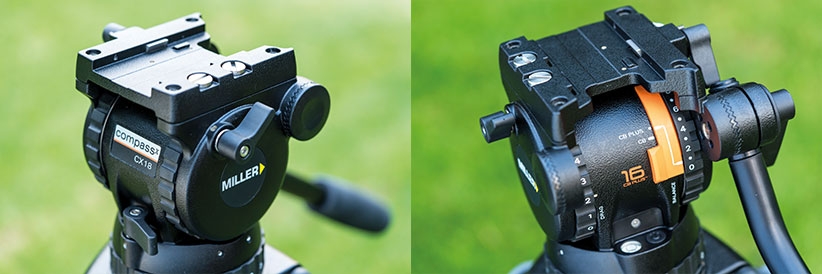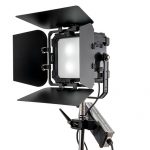
Miller CX2 Solo 75-3 and CX18 SII tripods
If all a tripod had to do was be burly enough to hold your camera in a fixed position, then all you’d need would be a basic set of sticks and a head, strong enough for your camera set-up. But the reality is that tripods have to be portable, fast and easy to set up, well-damped, rugged, as light as possible for the payload range, and be able to be balanced for a range of cameras.
Words: Adam Duckworth
Miller CX18 SII £5672/$5481
Miller CX2 Solo 75-3 £2212/$2138
And, of course, offer precise pan and tilt movements with no horrid snatch at the start of a move or the dreaded bounce-back at the end – something that’s a signature of a lesser head. A quality tripod that delivers all this will improve your shots and save time – and money – in reshoots ruined by jerky camera moves.
These are the reasons to push the boat out and invest in a top-quality professional tripod that will last decades. And costing up to £5672/$5481, one of these carbon fibre Miller tripods is undoubtedly a sizeable investment for most independent filmmakers. But you know that if you upgrade to a huge cinema camera with serious glass, as well as follow focus, a rig, a monitor and a mic, your tripod will be strong enough to hold the kit and adjustable enough to control it to perfection.
The Miller CX18 SII may cost as much as some cinema cameras but it is packed with high-tech spec and you’ll never outgrow it. It comes with the matching CompassX CX18 head in the largest 100mm bowl size which can handle the largest set-up at 16kg/ 35.2lb – ideal for even broadcast-size cameras. It can also be adjusted to work with a lightweight DSLR or mirrorless camera.
The CX18 kit is a traditional-style video tripod with a mid-level spreader. It comes with a pan handle, feet that work on smooth as well as uneven surfaces and a custom-fitted and padded case that is a seriously well-made bit of kit. As it should be, to protect something as pricey as the tripod and head inside. The legs are made of carbon fibre which is not only lighter than traditional aluminium but actually dampens out vibrations more.
The CX18 head is the largest in Miller’s range and provides 16 positions of counterbalance and the large tripod plate has 60mm of travel, so it’s easy to balance any camera and lens combo you could think of. AD There is a large adjustment wheel so it’s easy to quickly dial in just the right amount of balance. First you get the balance roughly correct, then engage the CB-Plus switch to make micro-adjustments to get it just right. The camera plate clicks firmly into place on the head, then is clamped down with a large, obvious lever. There’s an illuminated spirit level to ensure the head is set level, and adjustment is via a large adjuster knob under the head which is intuitive to use.

You can adjust the drag for the pan and tilt movements, again using two very large wheels. Setting zero is totally free-moving, while 1-5 offers an increasing amount of drag. And in use, there is no jerking at the start of a pan or bouncing at the end. It’s a top-quality head and you can feel it. The two issues with this type of tripod are in its weight, which at 7.4kg/16.3lb makes it not the lightest tripod to cart around with you. And the height range goes from 603-1693mm/23.7-66.6in. So for very low-angle shots or very high positions, you may need another option.
That option could come in the form of Miller’s CX2 Solo 75-3, a three-stage carbon fibre tripod which comes with the matching CX2 fluid head in a 75mm bowl size. Instead of the multi-tube leg set-up of its big brother, it has conventional telescopic legs and no spreader. This means it can go as low as 390mm/15.4in and reach up to 2040mm/80.3in. At 5.8kg/12.8lb, it’s significantly lighter than the CX18 but of course the payload is far more limited, at precisely half. It can still handle a very respectable 8kg/17.6lb which is plenty for most users. And it’s significantly more affordable
at £2212/$2138.
A lot of the weight saving comes from the legs; top-quality carbon fibre, adjusted using a twist-lock style clamp. This can be a tad slower to adjust than the clamps of the CX18 but once you get used to it, it becomes quick and easy. Legs like this are more suitable for outdoor use on rough ground, too; the feet come with rubber bumpers to protect hard surfaces and reduce vibration, but can be wound back to expose spikes for outdoor use.
The head itself is like a mini version of the CX18 with a 16-position counterbalance and the CB Plus system for fine-tuning, as well as three settings of fluid drag for pan and tilt as well as free-moving. The adjustment knobs are the same, large and obvious units as on the bigger head and the feeling is similarly smooth in use. There’s no sudden jerkiness and no nasty starts or stops. It’s a top quality bit of kit that is a joy to use and is built tough to deliver for years in all conditions.
The CX2 also comes in its own bag but it’s a smaller, triangular-shaped soft bag for easier transportation on the shoulder. If you can afford them, the CX2 makes an ideal tripod kit for location shooters on the move who need portability, and the CX18 is perfect for heavier cameras that don’t need to be moved around as much. They may cost a lot but should deliver for years and pay back that initial investment. AD
“A quality tripod will improve your shots and save time – and money – in reshoots ruined by jerky camera moves”
Specifications
CX2 Solo 75-3
Head Fitting: 75mm
Counterbalance: 16 positions
Leg Sections: 4 carbon fibre
Height range: 390-2040mm/15.4-80.3in
Maximum Payload: 8kg/17.6lb
Spreader Type: None
Head Type: CX2 fluid
Weight: 5.8kg/12.8lb
CX18 SII
Head Fitting: 100mm
Counterbalance: 16 positions
Leg Sections: 3 carbon fibre
Height range: 603-1693mm / 23.7-66.6in
Maximum Payload: 16kg/35.2lb
Spreader Type: Mid-level
Head Type: CX18 CompassX fluid
Weight: 7.4kg/16.3lb
PRO MOVIEMAKER RATING: 9/10
+Pros: Pretty much the best you can get
– Cons: The price is prohibitive for many










